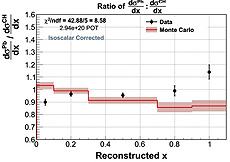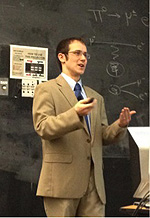Seeing more from the nucleus than the sum of its parts
 |
Ratio of iron (top) and lead (bottom) to plastic neutrino cross sections (interaction probability) as a function of how much momentum the struck quark has compared to a proton or neutron in the nucleus. |
Para una versión en español, haga clic aquí.
We can all tell that a lump of coal, a steel ball bearing and a lead brick are very different from one another, just by using our eyes. On the other hand, we know they are all just made up of different numbers of protons and neutrons in the nucleus, the atom's inner core. At MINERvA we use neutrinos to see these materials, and sure enough, the protons and neutrons seem to know whether they are inside coal, steel or lead. The surprise is that these "nuclear effects" are different from what you would predict from measurements using electrons to see those same nuclei.
The nucleus is a complex bound state of proton and neutrons, which are themselves complex bound states of quarks and gluons. The theory of particle physics tells us precisely how a neutrino interacts with a single quark inside a proton or neutron. However, in MINERvA, each neutrino hits not only individual quarks, but also sometimes protons or neutrons, or sometimes even the whole nucleus. Neutrino interactions also happen in many different ways: Sometimes they only change a neutron into a proton, and sometimes they break up a whole nucleus.
When MINERvA looked at the first kind of interaction, we saw that the previously understood simple picture of what the protons and neutrons are doing inside carbon was not correct. For this result, we look at a much larger range of neutrino interactions and a larger range of nuclei. Once again we have found that our simple model is not correct.
The above figure shows the measured probabilities (or cross sections) of a neutrino interacting with the material in different MINERvA targets. Specifically, they show the ratios of the neutrino cross sections for iron and for lead to those for plastic in different Bjorken x ranges. "Bjorken x" is the scientific term for how much of the proton's or neutron's momentum is carried by the struck quark.
The measurement is compared with the model used by most neutrino experiments, and we see that the heavier the nucleus, the more the data do not agree with the model: The data tell us that the heavier the nucleus, the more the quarks can get extra momentum. This would be possible if a quark can get extra momentum from the rest of the nucleus, a phenomenon that is not yet in the model. To obtain the best measurements of neutrino oscillations in the future, we will need to improve these models so that they can reproduce what we measured here.
Brian Tice of Rutgers University is writing his thesis on this MINERvA finding. He described the result at the Oct. 11 wine and cheese seminar. View the talk.
—Mousumi Datta
 |
Brian Tice of Rutgers University discusses this MINERvA result at the Oct. 11 wine and cheese seminar. |
|